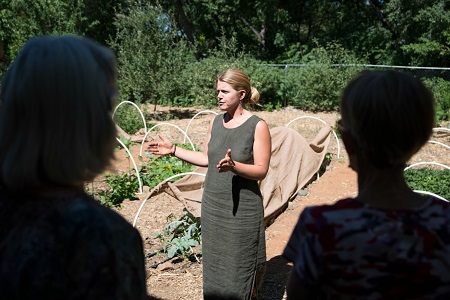 Micro-farming workshop participants toured the Commons' garden with Kristin Lundgren, Garden & Community Education Coordinator, to learn the secrets of small-scale farming. The Commons has produced over 1,500 pounds of food on less than an acre of cultivated land.Silver City, NM: Would-be micro-farmers attended a two-day training this week to learn the secrets of turning dirt into dollars at the Commons in Silver City, NM. The training was sponsored by the National Center of Frontier Communities (NCFC), part of their effort to expand food production in the southwest corner of the state.
Micro-farming workshop participants toured the Commons' garden with Kristin Lundgren, Garden & Community Education Coordinator, to learn the secrets of small-scale farming. The Commons has produced over 1,500 pounds of food on less than an acre of cultivated land.Silver City, NM: Would-be micro-farmers attended a two-day training this week to learn the secrets of turning dirt into dollars at the Commons in Silver City, NM. The training was sponsored by the National Center of Frontier Communities (NCFC), part of their effort to expand food production in the southwest corner of the state.
First and foremost, participants were advised to "build their soil" by Kristin Lundgren, Garden & Community Education Coordinator at the Commons and one of the workshop presenters. The heavily caliche soil in our region can benefit from amendments of sand and organics matter, like compost, to boost production.
Lundgren discussed the basics of micro-farming, defined as small scale agriculture in urban and suburban areas, typically on five acres or less. Lundgren's expertise in micro-farming has seen the Commons produce over 1,500 pounds of food on less than an acre of land.
Backyard gardeners and small-scale farmers can boost their income and the local economy by growing crops to sell at Farmers Markets, to food cooperatives or to NCFC's newest project, the Southwest New Mexico Food Hub that connects small-scale and medium-scale farmers to larger regional markets.
"It's amazing what can be done in a small space," said Tristin Pekron, a workshop participant from Deming. "The workshop had good information, and I appreciated the opportunity to learn more on micro-farming."
Silver City resident, who only wished to be identified as Jennifer, attended the workshop to continue to learn what foods grow well in the region. She said, "I always feel like gardening is a new experiment every year."
Workshop participants learned about soil, types of produce that grows well, irrigation and pricing their produce, and marketing their products.
The workshop was sponsored by a Local Farm Promotion Program grant received by NCFC from the United States Department of Agriculture (USDA), to promote outreach and education. NCFC program specialist, Ben Rasmussen helps coordinator the grant, and the Southwest New Mexico Food Hub.
"Our goal is to increase the number of local growers in the region and increase the local market share of our regional growers," said Rasmussen.
According to the USDA, less than $500,000 of the estimated $9.9 million in annual regional retail sales of fruit, vegetables and nuts is supplied by local growers in Carton, Grant, Hidalgo and Luna counties.
Even a small percent of increase in buying locally grown foods can have a larger impact on the economy. This "multiplier effect" refers to every dollar spent on local food tends to be recirculated in the local economy, stimulating more revenue so the original dollar's value increases to the tune of about $1.40 to $2.60.
Rasmussen said, "This workshop was a great fit for our region, with over 30 participants from Mimbres, Deming, Lordsburg and Silver City."
"Micro-farming allows people to use small tracts of land and their backyards, so they can garden part-time and have high yields, a which suits our frontier markets," said Rasmussen.
Rasmussen added, "Any overflow produce that micro-farmers have and would like to distribute, they can call the Food Hub as we have demand for more food and connection to the buyers."
Rasmussen promised another workshop in the Autumn based on regional growers' requests. "We will see what comes up over the summer as we go full steam ahead with the Food Hub."
For more information on the Southwest New Mexico Food Hub or NCFC contact Rasmussen at (575) 534-597-0032 or email: brasmussen@swchi.org or visit the website at http://frontierus.org/.
LFPP Funding for Comida Buena was made possible by the U.S. Department of Agriculture's (USDA) Agricultural Marketing Service through grant 16LFPPNM0002. Contents are solely the responsibility of the authors and do not necessarily represent the official views of the USDA.